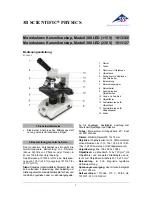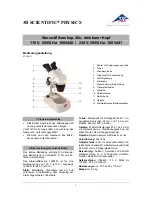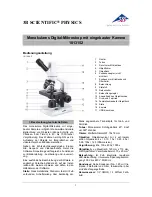
Axio Imager 2
OPERATION
ZEISS
Illumination and contrast methods
01/2016
430000-7544-001
183
If the positions of the section are less favorable, i.e. the center of the cross of optically uniaxial, or the
isogyre of optically biaxial specimens is outside the objective pupil, the optical character can be assessed
as follows:
•
The specimen is
optically uniaxial
if the isogyres are
straight
and run parallel through the pupil
(relative to the reticle).
•
The specimen is
optically biaxial
if the black isogyres are
curved lines
traveling across the pupil on a
circular path.
With appropriate care, even axial figures such as these (not illustrated in Fig. 204) can be interpreted.
Axial figures can often be more effectively represented by circular polarization. Determining the
axial angle of optically biaxial specimens (basically the space between isogyres) is much less
ambiguous as a result. The optical character can also be determined. The compensator
λ
(6 x 20), inserted in the compensator slot, is used for this.
4.12.7
Setting reflected-light brightfield
For all reflected-light contrasting techniques, the 6x20 compensators must be removed from
the light path (slot for compensators).
(1)
Application
Reflected-light brightfield microscopy is the simplest and most widely used microscopy technique for
examining opaque samples or specimens e.g. polished sections or wafers.
For true-to-object imaging, indirect ray bundles, i.e. ray bundles diffracted and scattered on the specimen
details, are of major importance besides the so-called direct ray bundles. The higher the proportion of
indirect rays (aperture), the more realistic the microscope image will be, according to ABBE's rule.
The incoming, bundled light from the reflected-light illuminator is reflected by a neutral-colored beam
splitter. Then it passes to the objective which focuses the beams onto the specimen surface (so-called
condenser function). The objective collects the light reflected by the object and generates the
intermediate image of the microscope together with the tube lens, which is then observed visually or can
be documented objectively.
(2)
Instrument equipment
−
Axio Imager MAT with connected and adjusted HAL 100 halogen illuminator.
−
H P&C reflector module in reflector turret, 6x20 compensator mount with darkfield stop for reflected
light (424706-0000-000) or 4-position modulator turret.








































